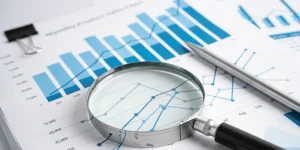From 2.8% to 0.8%: How New Tariffs Are Reshaping America’s Economic Future

Anúncios
The Economic Slowdown: From Robust Growth to Near-Standstill
The U.S. economy has taken a sharp turn from the robust growth of 2.8% in the previous year to a projected growth of just 0.8% in 2025.
This dramatic shift is causing concerns among economists and business leaders alike.
Sharp Rise in Recession Probability
One of the most alarming developments is the increase in the probability of a recession. Back in February, the likelihood of a recession stood at 25%.
However, this figure has now surged to 47%, indicating significant economic risks ahead.
Anúncios
This rise is largely attributed to the economic disruptions caused by new tariff policies and the uncertainty they bring.
Post-Pandemic Momentum Versus New Challenges
Initially, the post-pandemic period saw strong economic momentum.
Consumers were eager to spend, and businesses were keen to invest, driven by pent-up demand.
However, the landscape has changed dramatically with the introduction of new tariffs.
This policy shift is impacting trade dynamics, leading to increased costs for businesses and consumers alike.
Anúncios
The Role of New Tariffs
President Trump’s new tariff policy, particularly its reciprocal nature affecting over 50 nations with a minimum 10% fee, has been a game-changer.
The most significant impact is seen in the 145% tariffs on Chinese goods.
While there has been a temporary 90-day pause on some tariffs and exemptions for electronics, the overall effective rate still hovers around 23%.
This has created an environment of uncertainty, making it difficult for businesses to plan and invest confidently.
Looking Ahead
As we move forward, the economic outlook remains cautiously pessimistic.
Economists predict that growth will be anaemic at best, with potential for a mild recession in the latter half of the year.
The long-term implications include a gradual reduction of average tariff rates to 15% by 2026 and a potential shift in supply chains away from China.
The economy’s adjustment to these new realities will be crucial in determining the path ahead.
This precarious situation highlights the need for businesses and consumers to stay informed and adapt to evolving economic conditions.
Understanding Trump’s New Tariff Policy
Implementation of Reciprocal Tariffs
Trump’s new tariff policy, which includes reciprocal tariffs with a minimum 10% fee on goods from over 50 nations, marks a significant shift in America’s trade strategy.
These reciprocal tariffs aim to level the playing field by matching the fees other countries impose on U.S. exports.
While the intent may be to protect U.S. interests, these measures come with broad economic implications.
The introduction of these reciprocal tariffs has disrupted international trade flows and increased the cost of imports, making them more expensive for American businesses and consumers.
The policy targets a wide range of products, adding strain to industries that rely on imported raw materials and components.
Economists predict that these tariffs will lead to higher prices for goods, thereby reducing consumer spending and weakening overall economic growth.
Dramatic Increase in Chinese Tariffs
Among the most notable aspects of Trump’s tariff policy is the dramatic increase in tariffs on Chinese goods, which now face a staggering 145% fee.
This move significantly escalates the trade tensions between the two largest economies in the world.
The high tariffs on Chinese imports are intended to pressure China into trade compliance and address issues such as intellectual property theft and unfair trade practices.
However, this sharp increase in tariffs on Chinese goods has its downsides.
It is expected to lead to higher production costs for U.S. manufacturers that depend on Chinese materials and parts.
These increased costs are likely to be passed on to consumers, resulting in higher prices for goods ranging from electronics to everyday items.
The long-term effects may also include shifting supply chains away from China, which could disrupt existing business operations and create further economic uncertainty.

Temporary 90-day Pause and Electronics Exemptions
To mitigate some of the immediate negative impacts, the Trump administration has implemented a temporary 90-day pause on the new tariffs, along with exemptions for certain electronics.
This pause is intended to provide a brief reprieve for businesses and consumers while negotiations continue.
The exemptions apply to products such as smartphones, computers, and other electronics, maintaining an effective tariff rate of 23%.
While this pause and the exemptions offer temporary relief, they do not fully alleviate the concerns facing businesses and consumers.
The uncertainty surrounding the future of trade policies continues to weigh heavily on business decisions, with many companies hesitant to make long-term investments.
Moreover, the temporary nature of these measures means that the underlying issues remain unresolved, keeping the economic outlook uncertain.
Transitioning from the intricacies of new tariff policies, it is essential to understand how these trade measures affect consumer behavior and overall economic activity.
The Ripple Effects on Consumer Spending
With inflation expected to rise from 2.4% to 3.4% by the end of the year, consumers will likely feel the pinch in their wallets.
Let’s explore how rising costs and economic uncertainties are impacting consumer purchasing power and overall economic activity.
Inflation and Purchasing Power
Inflation essentially means higher prices for goods and services.
As tariffs drive up costs for manufacturers and retailers, these increases are passed on to consumers.
Consequently, goods and services become more expensive, leading consumers to tighten their belts.
This decline in purchasing power significantly impacts the economy since consumer spending drives about 70% of economic activity.
The Wealth Effect and High-Income Consumers
Another factor to consider is the reduced spending among high-income Americans.
Stock market volatility has led to decreased wealth for these individuals, making them more cautious with their spending.
Since high-income households contribute substantially to consumption, their reduced spending further dampens overall economic activity.
Impact on Economic Growth
The combination of rising inflation and reduced consumer spending suggests an immediate impact on economic growth.
With more money going towards everyday expenses, less disposable income is available for discretionary purchases, further weakening demand across various sectors.
This situation underscores the recession risks highlighted by economists, with predictions for a mild recession later in the year.
Although there is a temporary 90-day pause on many tariffs and specific exemptions for electronics, the ongoing uncertainty continues to loom.
This economic environment presents challenges, requiring careful navigation by businesses and policymakers alike as they adapt to the evolving landscape.
Business Investment and Market Response
The recent shift in tariffs has applied significant pressure on business investment, causing a marked slowdown.
Business investment growth is set to decline dramatically, with projections showing growth reducing from 3.6% last year to a mere 1.2% this year, according to Survey.
This precipitous drop can be attributed to several factors connected to the new tariff policy and overall economic uncertainty.
Chilling Effect of the New Tariffs
The implementation of new tariffs has introduced unprecedented costs for businesses.
With reciprocal tariffs affecting over 50 nations, and a staggering 145% tariff on Chinese goods, companies are seeing their expenses skyrocket.
The temporary 90-day pause provides very limited relief, as businesses struggle with planning under such uncertain conditions.
The unpredictable nature of future tariff policies makes long-term investment decisions fraught with risk.
The 90-Day Tariff Pause and its Impact
Though the Trump administration introduced a 90-day pause on tariffs and an exemption for electronics maintaining a 23% effective rate, this measure has not alleviated the broader concerns within the business community.
This pause only extends the period of uncertainty, making it hard for businesses to commit to major investments.
Industries reliant on global supply chains, in particular, are hesitant to make significant financial commitments without a clear understanding of future costs.
Job Market and Employment Concerns
The impact on the job market is also significant.
Economists predict an increase in the unemployment rate to 4.7%, up from 4.2%.
The rationale behind this forecast is clear: as businesses contend with rising costs and reduced investment capacity, they are likely to cut jobs to maintain profitability.
This trend may lead to a net loss of jobs and exert additional pressure on an already strained economy.
Transitioning Supply Chains
Moreover, the long-term implications of realigning supply chains away from China cannot be overstated.
As businesses adapt to avoid prohibitive tariffs, this transition period is expected to incur substantial costs and operational disruptions.
While these adjustments may lead to diversified sourcing strategies, the short to medium-term effects will likely contribute to lowered business confidence and investment reluctance.
Transitioning from this chapter, it becomes evident that these economic adjustments reflect deeper issues facing the broader economy.
As we further explore these interconnected factors, we gain a clearer view of the challenges and the complex dynamics at play.
Future Economic Outlook
Projections for a Mild Recession
Economists are increasingly predicting a mild recession in the second half of the year, with the economic growth forecast dropping from 1.7% to 0.8% by 2025.
The probability of a recession has risen sharply from 25% to 47% since February, underscoring a notably pessimistic outlook.
Reduction of Tariff Rates
Over the next few years, tariffs are expected to gradually ease from the current high rates.
By 2026, the average tariff rate could fall to about 15% as companies adapt by sourcing more products from countries other than China.
This reduction should aid in stabilizing the market and potentially lowering inflationary pressures.
Long-term Supply Chain Shifts
One of the broader implications of the new tariff policy will be the long-term shift in supply chains away from China.
This change will come with both opportunities and challenges.
While companies may find new and sometimes more reliable sources for goods, the transition will involve significant costs and logistical adjustments.
This reshuffling will reverberate across industries, influencing pricing, availability, and business operations on a global scale.
As we look towards these adjustments and their ripple effects, it’s clear that businesses and consumers alike must brace themselves for significant changes.
The reshaping of the economy will not happen overnight, but the long-term adjustments in tariffs and supply chain dynamics will shape the economic landscape for years to come.






